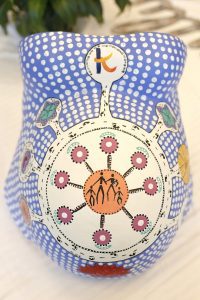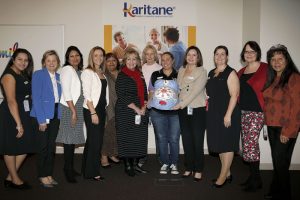
A belly cast celebrating new life was unveiled as part of Reconciliation Week, symbolising the unique health pathways available to new Aboriginal parents in South West Sydney.
The belly cast, a regular activity undertaken by families enrolled in the SWSLHD Sustained Home Visiting Program was handed over to Karitane staff by SWSLHD Director of Aboriginal Health Nathan Jones.
This event and the belly cast decorated by Bulundidi Gudaga Aboriginal health worker Heidi Sainsbury symbolises a unique pathway for Karitane, and South Western Sydney Local Health District (SWSLHD), Primary and Community Health, Child and Family Health Nursing teams to continue providing support for Aboriginal families.
Karitane’s chief executive officer Grainne O’Loughlin said she hopes the belly cast will encourage pregnant women and their families from the local Aboriginal population to access the services that Karitane offer such as the “Lil Possums” Aboriginal play group to reduce social isolation.
“The artwork on the Belly Cast signifies the collaborative pathways between our Aboriginal families and support services within the District as well as providing a beautiful decorative piece of art as a reminder of pregnancy and its journey into parenthood,’’ Ms O’Loughlin said.
“The visual aspect of the piece is to also raise awareness to families and staff at Karitane on the importance of Reconciliation,” Ms O’Loughlin said.
“Over the past 12 months Karitane have worked with Child and Family Health Nursing in strengthening relationships to ensure smooth transitional pathways for Aboriginal families within the Local Health District (LHD),” she said.
“We are very proud of our collaboration in helping to ensure that we provide Aboriginal Families with vital support in the early years of parenting.”
Working collaboratively has enabled expertise and resource sharing which SWSLHD Director of Aboriginal Health Nathan Jones said has helped with providing Aboriginal families with access to culturally appropriate programs.
“The Aboriginal sustained home visiting program engages with families up until a baby turns two and will help ensure key developmental milestones are reached and the child successfully transitions to school,” Mr Jones said.
“The rate of Aboriginal children fully immunised at 12 months is almost on par with that of non-Aboriginal children and the rate of Aboriginal children fully immunised at the age of five is actually higher than non-Aboriginal children and sits at over 95 per cent,” he said.

